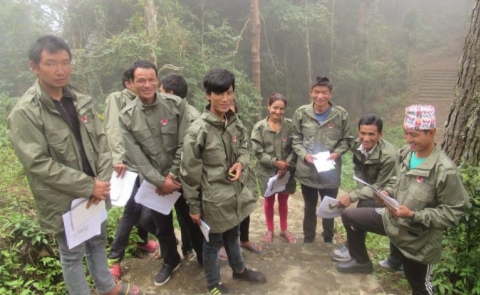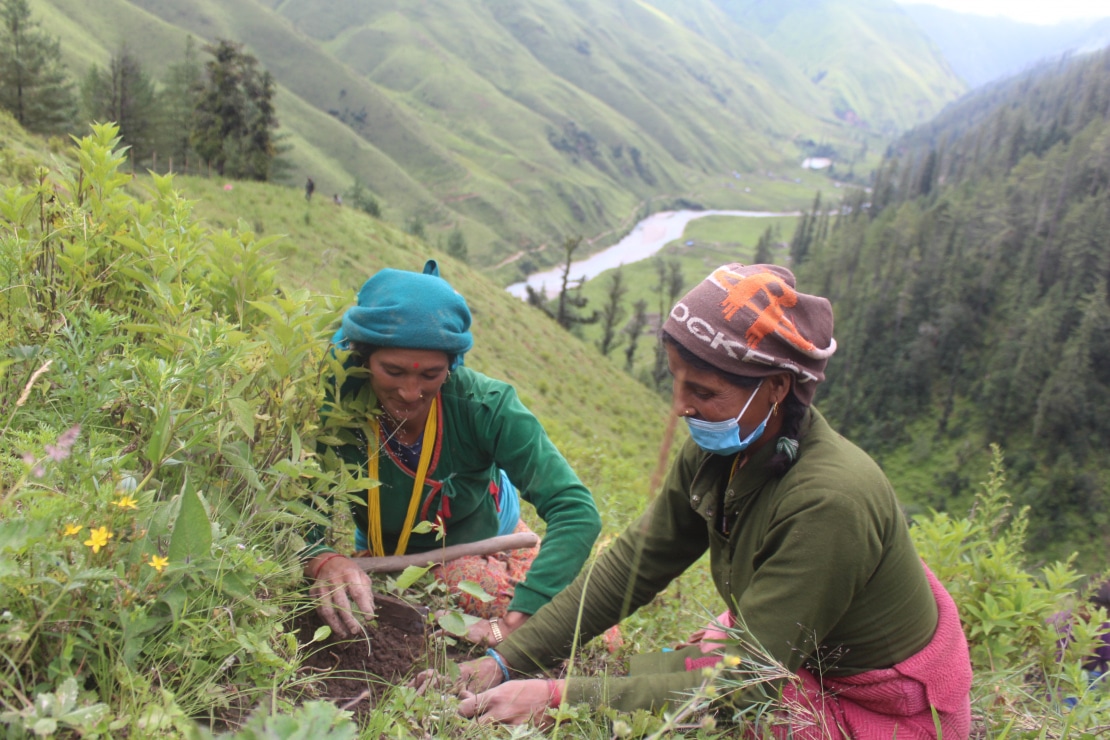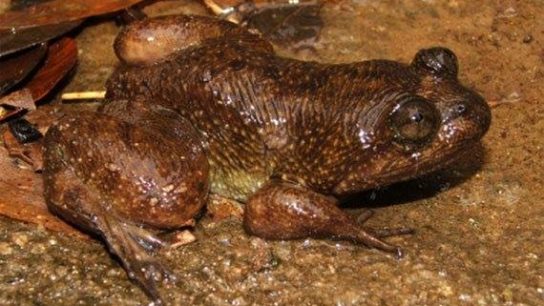The red panda, also known as the lesser panda, is an arboreal mammal inhabiting the Eastern Himalayas and China. With an initially mysterious taxonomic background, scientists first placed the red panda in both the bear family (Ursidae) and the racoon family (Procyonidae). However, after extensive genetic testing, the species was made the sole representative of the Ailuridae family. Testing further revealed the existence of two separate species, Himalayan and Chinese red pandas, refuting previous beliefs that the two constituted distinct subspecies. Despite growing international awareness garnered towards the protection of this unique animal, their survival is increasingly threatened by a wide range of anthropogenic pressures.
—
Family: Ailuridae
Genus: Ailurus
Species: Ailurus fulgens (Himalayan Red Panda), Ailurus styani (Chinese Red Panda)
IUCN Status: Endangered
Population: between 2,500 and 10,000

A red panda resting on a tree branch (photograph by Jessica Weiller for Unsplash).
1. Taxonomy
Despite common assumptions to the contrary, the red panda was actually discovered 50 years prior to the giant panda. The word “panda” is thought to have been derived from the Nepalese words “nigalya ponya”, meaning “bamboo eater”, and was subsequently ascribed to the giant panda due to certain morphological similarities it shared with the red panda. Aside from their appetite for bamboo, giant and red pandas share similar specialisations in the forefoot, male genitalia and masticatory system, and both species possess a “false thumb”: a carpal bone, or radial sesamoid, acting as an opposable sixth digit on the animal’s wrist. Although once believed to substantiate a close relationship between the two species, the discovery of a Miocene red panda relative (Simocyon batalleri) and a Late Miocene giant panda relative (Ailurarctos) suggested otherwise. Whilst the two fossils were found to possess the additional digit, scientists determined that the false thumb had evolved in each species for different purposes: as Ailurarctos shifted from a carnivorous diet to one consisting primarily of bamboo, the extra appendage aided with bamboo manipulation; Simocyon batalleri, on the other hand, remained a carnivorous mammal and so the additional digit is believed to have evolved for arboreal locomotion. The herbivorous diet of the modern red panda led to the digit developing a secondary ability of bamboo manipulation (known as “preadaptation”). This apparent coincidence has been described as one of the most dramatic cases of evolutionary convergence observed amongst vertebrates.
As such, the exact evolutionary history and taxonomic classification of the enigmatic red panda has long baffled scientists, as physiological, ecological and genetic similarities to species within the Ursidae (polar bears, black bears, brown bears, giant pandas) Procyonidae (racoons, ringtails, cacomistles, coatis), Mephitidae (skunks), and Mustelidae (weasels, badgers, otters, ferrets) groups have resulted in several differing opinions within the scientific community. After three decades of extensive testing, during most of which the red panda was contentiously placed within the Procyonidae family, recent genetic research has indicated a more isolated phylogenetic position for the red panda by placing it in a family of its own (Ailuridae). This classification indicates that the species represents a lengthy, uniquely separate evolutionary course; with its closest known relative (Parailurus) having gone extinct approximately two to four million years ago, the modern red panda has earned the title of a “living fossil” as the sole extant member of the Ailuridae family. Nevertheless, as Ailuridae forms part of the superfamily Musteloidea, along with the Procyonidae, Mephitidae, and Mustelidae families, red pandas are believed to be closest to racoons, weasels and skunks.
Apart from the red panda’s relationship to fellow Carnivora, scientists have long debated whether Chinese and Himalayan red pandas constitute two subspecies, or whether they are distinct enough to be regarded as two separate species. Whilst the distinction may not seem significant, erroneous classifications of basal taxa lead to a misunderstanding of the species’ adaptive mechanisms and evolutionary background, resulting in misinformed, ineffective conservation strategies.
Traditionally, the determination of species, subspecies and population delimitation was based on morphological and biogeographical data, as well as reproductive isolation. Limitations in genetic technology and insufficient sample sizes prevented studies from reaching definitive conclusions on the topic. Whilst morphological differences were evident – the Chinese red panda was found to have a longer skull, wider cheekbones, an inflated forehead, more distinctive tail rings, and less white fur on its face – scientists expressed differing views on whether the distinctions were sufficient to warrant a classification of two species. The difficulty with differentiation was exacerbated by the fact that red pandas found along either side of the The Nujiang River, previously considered to be the geographic boundary between the two species, were found to be morphologically similar. However, in 2020 a genetic study conducted by Yibo Hu and his colleagues at the Chinese Academy of Sciences determined that Chinese and Himalayan red pandas are in fact two distinct species. By using next-generation sequencing technology, Hu and his team were able to conduct a comprehensive analysis using 65 whole genomes, 49 Y-chromosomes and 49 mitochondrial genomes to demonstrate a significant inter-species genetic divergence, as well as to correct species distribution boundaries. The two species were found to have diverged approximately 250,000 years ago with minimal transfer of genetic variation between the two, and the Yalu Zangbu River was found to be a more accurate geographic boundary between the species.
In discussing the effects of the findings on conservation initiatives, Hu noted, “To conserve the genetic uniqueness of the two species, we should avoid their interbreeding in captivity… Interbreeding between species may harm the genetic adaptations already established for their local habitat environment”. Hu further stated that the Himalayan red panda requires more urgent protection, as a drastic population decline that occurred 90,000 years ago resulted in the Himalayan species exhibiting a small population size and low genetic diversity.

Red panda with tender bamboo stems (photograph by Steve Payne for Unsplash).
2. Diet
The red panda’s diet is primarily herbivorous, with bamboo accounting for approximately 95% of their sustenance. Scientists estimate that the red panda switched to its current bamboo-based diet approximately two million years ago. Believed to have evolved from the carnivorous Simocyon batalleri, red pandas have powerful jaws and dentition once used to crush the bones of prey, which now serve to grind bamboo. High in fibre, low in nutrients and composed of cellulose, which the red panda cannot digest due to its simple carnivore stomach, only 24% of the bamboo consumed by these remarkable animals is actually digested. Therefore, red pandas must eat around two kilograms of bamboo per day to attain the energy they need to survive. However, unlike the giant panda’s indiscriminate approach to consuming bamboo, the red panda tends to feed selectively on the most nutrient-dense, protein-rich part of the bamboo – the leaf tips and tender shoots – avoiding the culm. Despite the apparent inadequacy of bamboo as a food source, scientists believe that the sheer abundance and quick growth of the plant, as well as the lack of competition for the food source, account for its popularity amongst pandas. Aside from bamboo, red pandas have been observed foraging for fruit, acorns, roots, succulent grass, insects, grubs, and occasionally hunt for bird eggs and rodents. A predominantly solitary species, the red panda forages at night, dusk and dawn.
3. Appearance
Slightly larger than a domestic cat, an adult red panda weighs between 3.6 and 7.7 kilograms and averages a bodily length of approximately 56 to 62 centimetres, with its lengthy tail adding an additional 37 to 47 centimetres. The red panda’s iconic ruddy coat serves as a form of camouflage for the animal within the forest canopy, blending in with the brownish-red moss clumps and white lichens which cling upon the branches of fir trees. Their black bellies further prevent predators from locating them from the ground.
Other distinctive features include their large, pointed white ears, short snouts, and the white markings above the species’ eyes and on their cheeks, believed to be an evolutionary adaptation to keep the sun out of their eyes and for cubs to locate their mothers in the dark. In addition to a soft, dense and woolly undercoat, layered beneath longer, courser hair, the red panda utilises its thick bushy tail to keep warm against the windchill of the high-altitude forests they inhabit. As opposed to paw pads, fur covers the entirety of the red panda’s paws, enabling them walk in snow and climb slippery trees with ease. Aside from their furry paws, red pandas have a number of features that assist with their arboreal lifestyle: sharp, semi-retractable claws; five separate toes; the aforementioned false thumb; a large tail for balance; and specialised, extremely flexible ankles that can rotate 180 degrees. As such, red pandas are one of the only animals that can climb head-first straight down a tree.
As mentioned, the two distinct species of red panda have slight variations in their appearance. Aside from the relative size advantage held by the Chinese red panda, the key distinguishing feature between the two is the colour of their face and tail. Whilst the Himalayan red panda has more white fur around its head and face, the Chinese red panda sports a more reddish complexion. Similarly with their tails, the Chinese red panda boasts more distinctive, defined rings on its tail, with darker red and lighter beige strips, whereas the Himalayan red panda’s red and orangey ringed tail is somewhat less conspicuous.

Himalayan red pandas have whiter faces and less distinctive rings on their tails (photograph by Jenna for Unsplash).
4. Habitat and Behaviour
Once widely distributed across Eurasia, the remaining red panda population is now restricted at the southern and southeastern fringes of the Qinghai-Tibetan Plateau. Whilst Chinese red pandas are located in northern Myanmar, southeastern Tibet, Sichuan and Yunnan provinces, Himalayan red pandas are found in Nepal, India, Bhutan, and southern Tibet in China. The species inhabit temperate forests with bamboo understories at altitudes of 2400 to 3900 metres. They are largely arboreal, spending the majority of their day in trees, and are primarily crepuscular, foraging between dusk and dawn. As an obligate bamboo feeder, the red panda runs on a relatively tight energy budget and is therefore asleep for 55% of the day. When faced with excessively cold conditions, these incredible creatures are able to enter a state of “torpor” by lowering their metabolic rate, respiratory rate, core temperature and becoming dormant, utilising the same amount of energy as a sloth and raising their metabolism only to forage for food every few hours. As mentioned, their thick tails also assist with internal temperature regulation as resting pandas will curl into a tight ball to conserve heat. During warmer months, red pandas release heat and stay cool by panting and stretching out across branches.
Red pandas are generally solitary animals, except during mating season, with a home range of approximately 2.5 square kilometres. When crossing paths with a fellow red panda, communication occurs through tail arching, head bobbing, squealing, twittering, or though huff-quacks: a unique vocalisation similar to a duck quack and a pig snort. When threatened, red pandas may also stand on their hind legs and emit a hiss, grunt or bark, whilst distressed young cubs often let out a high-pitched whistle or bleat. Similarly to skunks, frightened red pandas will also release a sharp, pungent liquid from their anal glands to ward off any predators.
Aside from repelling predators, red pandas utilise their scent glands, as well as their urine, for marking territory. These markings hold information about the individual’s sex, age, and fertility, which facilitates the search for mates during breeding season. In addition to the malodorous spray that emanates from the anal glands, red pandas also have scent glands on the bottoms of their feet which exude a liquid completely colourless and odourless to humans. Adding to the species’ list of incredibly unique adaptations, the red panda tests odours with the underside of its tongue, as it has a coned structure for gathering liquid and holding it up to a gland inside its mouth. It is the only member of the Carnivora order with this specialisation.

Red pandas are asleep for 55% of the day (photograph by Joshua J Cotten for Unsplash).
The red panda is known as a K-selected species, indicating that females bear only a few offspring but invest a greater amount of time into parental care. However, such species have adapted to breed and rear offspring within a stable environment, and are thus less likely to survive within a rapidly changing habitat. In the wild, red pandas are typically observed bearing litters of singletons or twins, with most births occurring in late spring when there is an abundance of tender, digestible bamboo leaves and shoots. As a K-selected species, the red panda also has a relatively long gestation period of 93 to 156 days, though some attribute this to their slow metabolic rate. Similarly to giant pandas, female red pandas are fertile for just one to two days per year, but are able to delay the implantation of a fertilised egg for weeks. Females will create nests within tree holes, hollow tree stumps, roots, or bamboo thickets, utilising moss, leaves and soft foliage to line the nest. Cubs are extremely small when born, weighing around 90 to 110 grams, and thus require weeks of nursing and grooming before opening their eyes. After approximately one year, a cub is considered fully-grown and able to leave its mother, later reaching sexual maturity at 18 to 24 months.
5. Ecological Importance
Due to its largely herbivorous diet, the red panda plays an incredibly crucial role in maintaining its surrounding ecosystem and habitat. With each individual red panda consuming roughly 20,000 bamboo leaves and tender stems per day, this magnificent species prevents the overgrowth of bamboo forests, maintains the overall health of understoreys, and thereby supports a myriad of cohabitating species and organisms. Since bamboo plays a critical role in balancing atmospheric oxygen and carbon dioxide levels, releasing 35% more oxygen than an equivalent grouping of trees, their maintenance further benefits the overall quality of the planet’s air. As such, the red panda is an indicator species for the Eastern Himalayan broadleaf forest ecosystem, their presence or absence providing insights into the quality and condition of the environment. Growing international awareness surrounding their plight has further earned red pandas the role of a flagship species, as fellow vulnerable and endangered Himalayan-endemic species inevitably benefit from efforts to protect the red panda and the habitat they share.
More broadly, the red panda is an incredibly unique evolutionary marvel as the only extant member of the Ailuridae family. As aforementioned, the red panda represents a long evolutionary course which has yet to be studied fully, with the species exhibiting exceptionally distinctive morphological and behavioural adaptations that shed light on our planet’s natural history and ecology. The entirely preventable extinction of the red panda would be a great loss for scientists, conservationists, and the greater natural world alike.

The red panda is the sole extant representative of the Ailuridae family (photograph by Micheal Payne for Unsplash).
6. Threats
Due to the red panda’s evasive, timid nature, population estimates currently range between 2,500 and 10,000 individuals. Despite this uncertainty, comparisons with population estimates from 1997, combined with forest loss rates and the increasing presence of anthropogenic pressures within key red panda habitats, indicate a plausible population decline of 50% between 1996 and 2015. As this is predicted to intensify over the next 18 years, the red panda has been listed as ‘Endangered’ under the International Union for Conservation of Nature (IUCN) since 2015. Although habitat loss, degradation and fragmentation pose the greatest risk of extinction to the remaining wild red panda population, these issues are heavily compounded by wider concerns of climate change, overpopulation, lack of legislative enforcement, invasive species, and the illegal wildlife trade.
Over 75% of original Himalayan habitats have suffered degradation or been lost entirely to human needs. With a population growth rate of 3.3% per annum, the Himalayan mountain population is predicted to experience a 13-fold increase by 2061, from a current 53 million to approximately 260 million. As a large percentage of this population lives below the poverty line (earning less than two US dollars per day), this rapid and unsustainable growth has ultimately placed a tremendous amount of pressure on the surrounding environment to serve as a source of income and livelihood. The collection of fuelwood, logging, agriculture, hydro-projects, anthropogenic forest fires, and the creation of human settlements are amongst the primary reasons for deforestation.
As Himalayan cattle show a preference for rich bamboo under-storeys, gentle slopes, and a proximity to water sources, herders often allow domestic cattle to graze within key red panda habitats. As such, cattle often trample bamboo, which is collected by herdsmen for fodder, and compete with red pandas for tender leaves and stems. Livestock also cause extensive environmental degradation through overgrazing, desecrating the composition of natural forest ecosystems upon which a myriad of organisms depend.
The clearing of canopy trees by logging companies places further pressure on bamboo forests, as the removal of these shelter tress exposes bamboo to stress from wind and water, damaging existing plants, destroying seedlings, and preventing the regeneration of the forest. Such harsh conditions are particularly threatening to bamboo forests, which sporadically undergo mass flowering followed by die-off, as bamboo is climatically-sensitive and therefore unable to re-establish in areas of deforestation and degradation. Within the mountainous Imawbum region of Myanmar over 5,000 square kilometres of forest area has been logged since 2000, prompting the construction of numerous roads connecting the forest with cities in Myanmar and China.
This concomitant construction of roads and electric lines pose further risks to red panda populations by destabilising substrate and triggering landslides, fragmenting forest habitats, and facilitating poaching by providing hunters with easier access to previously unreachable areas. Isolated in small pockets of forest with little sustenance, exposed to starvation and poaching, red pandas become incredibly vulnerable to novel threats when crossing unfamiliar terrain in search of palatable bamboo. Facilitating this perilous situation is the fact that a large proportion of red panda habitat lies outside of protected areas within the species’ endemic countries. In Nepal, 70% of red panda habitat is found outside the boundaries of protected areas and national parks; as a result, this habitat has been fragmented into 400 isolated, small forest patches. For populations found within protected areas, insufficient staffing, inadequate incentives for rangers, difficult terrain, inaccessibility of red panda habitat and complex geopolitics enable illegal logging, agriculture and poaching to continue within the supposedly protected regions.
Red pandas are not able to adapt and survive in unsuitable habitats, devoid of tender bamboo, water sources, and adequate elevation. As aforementioned, K-selected species require stable environments in order to breed and rear the small litter of offspring they bear successfully. A study conducted in 1991 demonstrated that red panda mortality rates were unsustainably high in disturbed areas. Within the period of the study, only 3 cubs of the 12 to 13 born survived to six months of age, and just five out of nine adults remained alive. They determined that 57% of the fatalities were caused by anthropogenic stressors.
Another major threat facing the red panda is the introduction of invasive species, such as feral and domesticated dogs, to their natural habitat through agriculture, cattle herding and human settlement. Red pandas are extremely susceptible to rabies, as well as a viral disease known as canine distemper, which have caused a signifiant number of fatalities amongst the species’ population. Due to limited resources, funding and the failure to enforce regulations surrounding the annual vaccination of domesticated dogs in countries such as India and Nepal, canine distemper and rabies are a common occurrence in dogs between the ages of one and five. As farmers, herders, and foragers increasingly encroach upon red panda habitat, dogs are introduced to the area for hunting, protecting cattle, or as free-roaming strays. Consequently, instances of contact between wild red pandas and dogs have been rising, thus exposing the species to the fatal diseases through physical attacks or contact with dog excreta. Cases of canine distemper spillover have been documented in various other species, such as Indian foxes and tigers, with vaccinations proving ineffective amongst wild mammals. Feral dogs also prevent red pandas from foraging effectively, forcing them away from certain habitats, and pollute their water sources with seven different types of gastrointestinal parasites.
Perhaps the most complicated of the threats facing wild red panda populations is the illegal wildlife trade. Due to the species’ patchy distribution in the high-altitude forests of the Himalayas, researchers have little information on the illegal capture and trade of red pandas. Instances of red pandas accidentally getting caught in traps and snares intended for other animals, such as deer and pigs, and subsequently being sold for their pelts is a well-documented occurrence. However, early investigations into the trade failed to uncover a clear market for red panda products, as confiscated pelts were rarely designated for export to other countries and only poachers were ever intercepted by authorities. Prior to the red panda being listed under Appendix I of the Convention on International Trade in Endangered Species of Wild Fauna and Flora (CITES) in 1995, red pandas were commonly caught live in Myanmar, transported to China and later sold to zoos around the world. Reports in 2010 and 2012 also noted sightings of red panda fur caps in Bhutan and Nepal, carcasses and skins in eastern Myanmar’s village homes, pelts for sale in China, social media posts advertising the sale of live red pandas in China, as well as dishes containing red panda meat in Chinese restaurants.
Then, in 2015 conservationists began reporting a notable increase in cases of illegal red panda trading in Nepal, based on the quantity of traders and poachers intercepted in the region. Despite peaking in 2017 with the seizure of 27 pelts, researchers continued to find little evidence of a demand sufficiently stable and strong to warrant the rise in poaching cases. Therefore, in 2020 a group of researchers from the University of Queensland set out to elucidate the illicit red panda trade in Nepal in an attempt to understand what prompted the increase in trading. The study indicated that a large proportion of human populations living in close proximity to red panda habitats were aware of the species, but did not ascribe any ethnozoological value or significance to the animal. Instead, the study suggested that the market is potentially driven by previous investigations into the red panda trade, after undercover investigators inadvertently created the illusion of a market for the animals by posing as buyers. Mainstream media disseminating inaccurate information on the market value of red pandas and informing impoverished local populations of the price of pelts confiscated from poachers, without stating the species’ ecological and conservation importance, may have encouraged an increase in poaching as these regions tend to lack viable sources of income. As lead author of the study Damber Bista noted, “[the] unstoppable supply of pelts indicates the presence of a fake market with almost no buyers, which is solely based on rumours…Awareness building campaigners, security personnel and media personnel are the suspected sources of such rumours”.
Studies and surveys conducted by the Red Panda Network further corroborate these findings, noting that poverty, unemployment, and misinformation are the driving forces behind the illegal wildlife trade in Nepal. In a report released by the International Labour Organisation, it was shown that 63% of Nepal’s population are under 30 years of age, and amongst this population the unemployment rate sits at 19.2%. As such, pressures to find adequate avenues for income are incredibly high in the region. The false narrative of the illegal wildlife trade constituting a get-rich-quick scheme with high financial returns has unfortunately encouraged young locals from low socioeconomic backgrounds to try their luck at poaching.
Difficulties in monitoring illegal activities within red panda habitats were exacerbated by the outbreak of the Covid-19 pandemic, as restrictions and lockdowns deprived locals of various sources of income whilst leaving endangered wildlife and protected areas unguarded. With many having lost their jobs in cities and neighbouring countries, locals returned to their villages and faced the risk of abject poverty. Tempted by the absence of anti-poaching patrols and surveillance operations, ordinarily carried out by law enforcement agencies, poachers roamed the forests relatively unhindered. After 12 pelt confiscations in 2019 and a further 10 confiscations in 2020, the figure suddenly rose to 27 pelts in late 2021.
You might also like: 10 Interesting Facts About Pandas
7. Conservation
Over the past few decades, the plight of the red panda has garnered increasing national and global awareness, with local and international NGOs working incredibly hard to implement effective conservation strategies and compel local governments to strengthen their protection measures. Despite the species’ recognition in Appendix I of CITES, Schedule I of the Indian Wild Life (Protection) Act 1972, China’s Wild Animal Protection Act, Myanmar’s Wildlife Act of 1994, as well as in legal protections granted by Bhutan and Nepal, it is the work of researchers and activists at the frontlines of red panda conservation that have made the most significant difference. As outlined by the International Union for Conservation of Nature, there are four primary categories of action for the conservation of red pandas: protection against habitat loss; reduction of habitat degradation; reduction in anthropogenic red panda fatalities; and improvement of global awareness.
Community outreach and local involvement in red panda conservation strategies is incredibly important for their success, as the current lack of education and livelihood opportunities, coupled with the remote, patchy distribution of red pandas, effectively hinder any attempts to protect the species against poaching and habitat loss. In 2007, the Red Panda Network established a conservation program in the Panchthar-Ilam-Taplejung corridor, a strip of protected forests that connects protected areas in India and Nepal, where locals were given the opportunity to earn a living by working as Forest Guardians. These Guardians were tasked with patrolling red panda habitats, monitoring populations, and reporting any anthropogenic threats. Since its inception, the initial group of 16 Forest Guardians has since grown to 111 members, and their range has expanded to seven districts in western Nepal. This new range covers 50% of Nepal’s red panda habitat and secures the connectivity of three protected areas.

Red Panda Network Forest Guardians (photograph courtesy of Red Panda Network).
Further bolstering the work of the Red Panda Network’s Forest Guardians is their collaboration with the Rainforest Trust in establishing a new 430,050 acre protected area, connecting three other reserves in Nepal and India. This area covers multiple elevation zones and constitutes a vast, contiguous region of Himalayan forest on which a myriad of species depend. By employing local tribes and villages to monitor, organise, and manage the community forest reserve, all of which hold religious and cultural beliefs that regard wildlife with respect, these disadvantaged communities are given the opportunity to earn a sustainable income and exemplify environmental stewardship. Data collected from monitoring activities in protected areas allows the Red Panda Network to better understand the species’ ecological background, as well as the effect of anthropogenic pressures on red panda populations, and thus enables the organisation to design effective, science-based conservation strategies.
Aside from the Forest Guardian program, the Red Panda Network has worked to introduce a number of alternative sources of sustainable income to communities living around red panda habitats. These indigenous, often marginalised communities are typically dependent on forest resources and are accustomed to a specific lifestyle. By building a relationship of trust and understanding, the Red Panda Network has been able to demonstrate sustainable herding practices, organic farming, handicraft production, bio-briquette production, sustainable energy use, homestay management, eco-tourism practices, and have provided safe, clean cooking appliances to improve the lives of both locals and wildlife. As opposed to viewing the forest as a source of a quick and easy income, communities are given the opportunity to change their perspective and support the forest as a source of long-term benefit.

Red Panda Network Plant a Red Panda Home Program (photograph courtesy of Red Panda Network).
Targeting wider demographics, the Red Panda Network has also implemented a number of education initiatives that aim to educate local school children on the ecological and conservation value of the red panda, its habitat, and the Himalayan forests in general. As well as integrating species conservation into school curriculums throughout the Panchthar-Ilam-Taplejung corridor, Forest Guardian workshops have collaborated with local schools in organising Roots and Shoots groups and eco-trips for their students. Combined with radio broadcasts, posters, signs, public workshops, and the endorsement of local celebrity Dayahang Rai, approximately 49% of populations living within Red Panda Network project regions, including 23,000 students, have been reached by education initiatives. Through these campaigns, the Red Panda Network has endeavoured to dispel misinformation regarding the value of illicit red panda products, as well as inform the public on the dangers of involvement in the illegal wildlife trade.
As mentioned, fatal diseases such as rabies and canine distemper are a growing threat to wild red panda populations, as human settlements and agricultural workers encroach upon red panda habitat. Since disadvantaged communities are generally unable to provide annual vaccinations for their feral and domesticated dogs, organisations such as the Red Panda Network, in collaboration with local community partners, have succeeded in offering free vaccinations to 2,300 dogs in 6 of Nepal’s red panda range districts. In addition, the Red Panda Network works with local agencies and community organisations to establish vaccination and neutering programs for the domestic and free-roaming dogs of Nepal’s eastern and western districts.
Zoos across the globe have also played a significant role in conservation efforts by creating a Global Species Management Plan (GSMP) closely allied with field conservation strategies. The purpose of the GSMP is to directly and indirectly contribute to red panda conservation by, “providing a genetically and demographically sustainable and behaviourally competent back-up population for the wild population; holding the potential to supply individuals for genetic or demographic supplementation or reintroduction programmes; educating and the raising of public awareness of Red Panda, its uniqueness and conservation needs; and providing financial, technical, scientific and other support and expertise to the planning and implementation of in situ conservation and research”. In addition to the management plan, the international zoo community initiated and funded three Population and Habitat Viability Analysis (PHVA) workshops, whereby representatives of key countries shared primary or novel threats faced by red pandas within their region, as well as potential habitats to protect and conservation strategies to implement.
NGO Spotlight
As mentioned, the Red Panda Network (RPN) has been at the forefront of red panda conservation within Nepal, conducting numerous campaigns and initiatives involving local communities in an effort to protect native red panda populations. In addition to the numerous achievements noted above, the RPN has organised training sessions and workshops for Border Outpost Police to educate them on the importance of conservation and provide insights into the illegal trade. They further provide logistic support to Division Forest Offices and the Wildlife Crime Control Bureau, have created a field guide on red panda pelt identification, and have created a network of anti-poaching units to gather information on red panda poachers, buyers and traders in key export districts. The ‘Plant a Red Panda Home’ campaign has succeeded in planting 134,393 trees in eastern Nepal’s red panda habitat, over approximately 66 hectares, thereby connecting fragmented forests with a protected biological corridor. By engaging local governments, Community Forest User Groups and District Forest Offices in workshops regarding the ecological importance of red pandas, the Red Panda Network strives to ensure these policymakers adopt and implement conservation strategies in their respective regions.
In collaboration with the Charles Sturt University of Australia, the Government of Bhutan, World Wildlife Fund, and Australian Landcare International, and funded by The Darwin Initiative, the Red Panda Network has also assisted in creating a five-year Red Panda Conservation Action Plan for Bhutan. As the status and density of populations within Bhutan are relatively unknown, the plan aims to gather information on local red panda population dynamics, ecological roles, socio-cultural significance, and breeding habits; after which effective protection, community awareness and engagement campaigns can be developed. If successful, this collaborative effort, driven by the extensive knowledge of red panda conservation held by the Red Panda Network, can be further applied to all red panda endemic countries.
How to Help
- Support a conservation organisation. There are numerous NGOs, both local and international, that are hard at work implementing effective conservation measures for the protection of red pandas, such as the Red Panda Network. You can support these organisations by donating, volunteering, fundraising, and raising awareness.
- Cut down on your paper and plastic use. As mentioned, deforestation and logging are two major threats that wild red panda populations face. Reduce the amount of paper and plastic you purchase, and recycle any that you do.
- Spread the word. As mentioned, the illegal red panda trade is currently driven by false rumours regarding the financial value of red panda products. Let your family and friends know of the circumstances surrounding the illegal red panda trade and how supporting education initiatives such as those implemented by the Red Panda Network can help solve the problem.
If you want to learn more about endangered species, make sure to check out other articles from our Endangered Species Spotlight Series




















